#history of western astrology
Explore tagged Tumblr posts
Text
WESTERN ASTROLOGY – THE ORIGINS AND FACTS ABOUT WESTERN ASTROLOGY
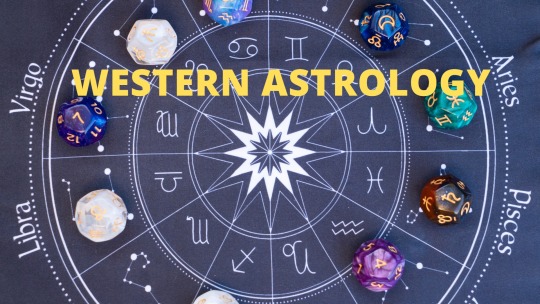
Western astrology is a system of divination based on the position of the planets and stars at the time of a person’s birth. It has its roots in ancient Babylonian astronomy and was later developed by the Greeks and Romans. Western astrology uses a zodiac system that divides the sky into twelve sections, each represented by a different astrological sign. Each sign is associated with certain characteristics and traits, and the position of the planets and stars at the time of a person’s birth is believed to influence their personality, relationships, and life path. Western astrology can be used for personal guidance, relationship compatibility, and even predicting future events. While some people view it as a form of entertainment, others take it very seriously and use it as a tool for self-discovery and personal growth.
Read full Information Source Link
#astrology#western astrology#vedic astrology#hindu astrology#indian astrology#sidereal astrology#best astrology#western astrology lessons#vedic vs western astrology#western astrology lecture#vedic and western astrology#history of western astrology#difference between eastern and western astrology#western astrology vs vedic astrology#vedic astrology vs western astrology#gregorian calendar western astrology#natal astrology#the astrology podcast
2 notes
·
View notes
Text
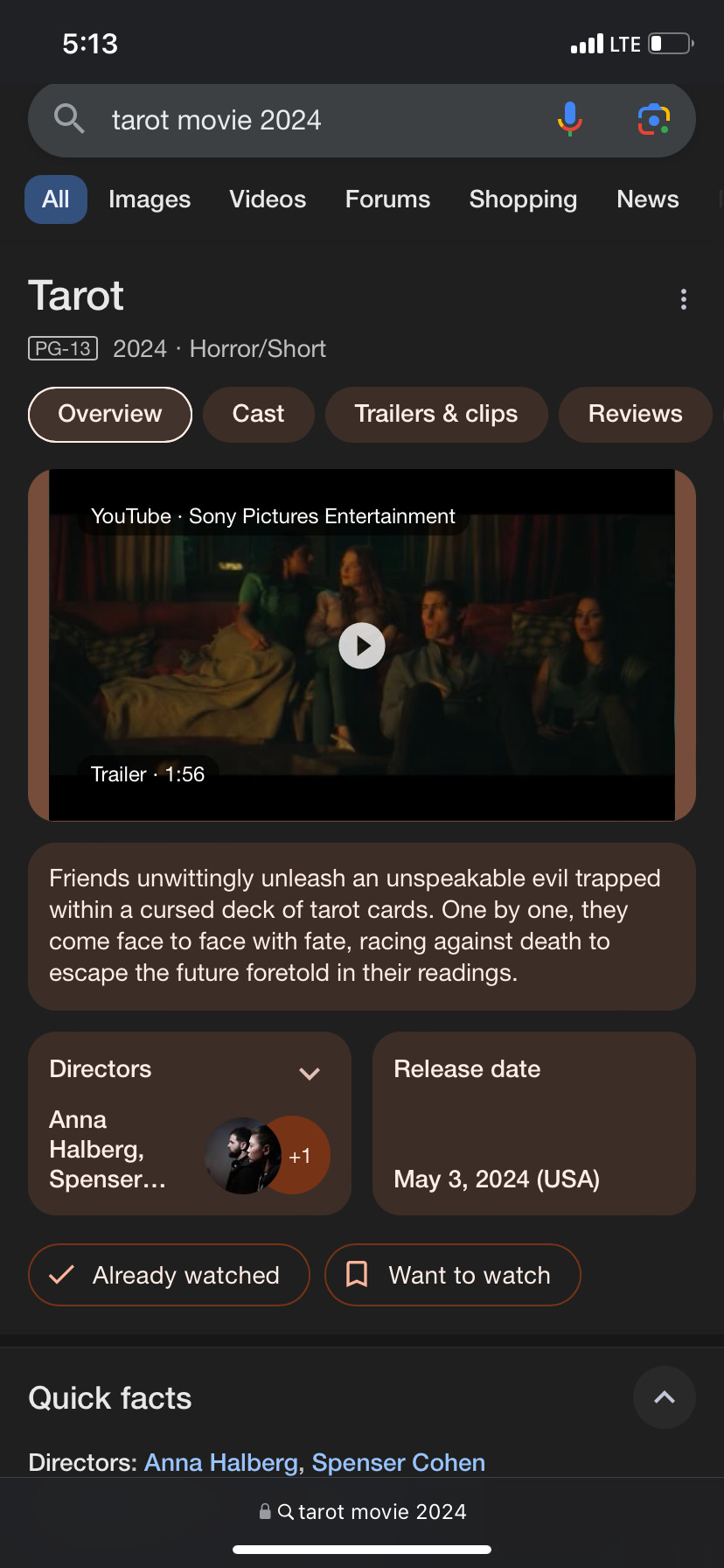
Community does not need this!! But they’re loud in the comments about how harmful this could be for the community and divination and other spiritual practices and traditions! Thankfully!! I was just talking about spiritual psychosis on my close friends on Instagram yesterday and then I see things like this and post just went viral of some woman absolutely losing it, snot running out her nose and everything over the eclipse.
The fear mongering and demonization of spiritual teachings, astrology, tarot and spiritual practices and traditions is about to start becoming very big. It was already a really prominent thing oppressors have used for ages especially against poc who practice forms of witchcraft or deity worship they brought with them from home. I was just watching a docu-series yesterday that highlighted how the native population on mt. Shasta were forced to leave and practiced ritual and held ceremonies in the caves of mount Shasta and those who colonized would go into those caves after they left and preform mockeries of their ceremonies and rituals as entertainment.
We’re about to step into a reality and time where spiritual people, practitioners and others within the community will be replacing celebrities and individuals of high rank or people who hold a lot of power in this world and I said before that the oppressor has a very specific recipe for oppression and trying to keep people (especially in the west) as unaware and as stuck in perpetual karmic cycles and systems as much as possible. And this is just yet another technique they use to discredit individuals with gifts. They use psychics and astrologers and others themselves to help them predict and interpret what’s coming.
They use these types of stories or ideas to fuel radical religious beliefs and ideas that are built upon fear mongering and hatred, they use religious institutions and manipulated versions of their Bible and beliefs and create division within the west. Vast majority of republicans are statistically uneducated and are conservative who hold onto heavy religious beliefs and views to back up, support and justify their actions and beliefs. Heavily similar to antebellum America and the justification of slavery and the mistreatment of African American people.
youtube
To add onto that, this movie about tarot does not accurately portray what tarot really is and how it works whatsoever but guess who’ll believe it and perpetuate it. Half the negative ideas that are swirling around about metaphysical, Wiccan or spiritual practices are due to pop culture and horror movies and the individuals who sit at their desks in the dark scribbling away these plots and releasing these movies.
#tarot movie#tarot community#divination#demonization of intuitives#demonization of spiritual practices#Youtube#santeria#bruja#hoodoo#voodoo#poc#poc in the United States#history of witchcraft#spiritual community#psychic intuitive#astrologers#fear mongering#the western world#oppression#colonization#project 2025#making America fucking shitty again#Biden#trump#conservatives#social media#movies#censorship#new earth#tarot cards
67 notes
·
View notes
Text
A Study in Astrology:
Arising from its ability to indicate the seasons and their respective natural activities, astrology has played a massive part in human cultures.
The importance of them even goes as far as to indicate what a person is like when they are born.
Rather than the stars being determinators of a person’s character, I believe astrology is a tool that God gave us to be more introspective of ourselves.
To honestly look inside ourselves and see who we truly are and what we need, whether it’s to enhance our strengths or address our flaws.
Below is how I interpret the planets and the stars. I highly encourage the reader to use this as a tool for their own interpretation of or investigation into astrology.
Planets:
I am only considering those planets that would have been visible to the naked eye as they would be the ones that would indicate events. I will also include which Babylonian god rules them.
The first three are what is considered the inner world of a human
Sun ☀️ _the ego, consciousness _ Shamash
Moon 🌙 _ Emotion, unconsciousness _ Sin or Selardi
Rising/ Ascendant/ 1st House ⭐️ _ expression _ as it the constellation that is rising from the horizon at one’s birth
The following are how one interacts with the world
Mercury ✍️ _ communication, logic _ Nabu
Venus ♥️_ expression of love _ Ishtar
Mars 🔥 _ passion, drive_ Nergal
The next two planets are both about growth as indicated by their brightness & must always be considered together.
Jupiter 💼_ ambition, “to reach” _ Marduk
Saturn 🧙♂️_ wisdom, experience_ Ninurta
Descendant/7th House/House of Balance_ the shadow self, the part of a person one doesn’t realize that they have_ the star sign which setting on the horizon at the time of one’s birth
Stars
Each constellation and their symbols are tired very closely with the mythology of different ancient cultures: Babylonian, Egyptian, and Greek just to name a few.
They will be listed according the Babylonian New Year, which began in March-April
Aries ♈️ _ Babylon_ Agrarian worker -> ram due to association with Dumuzid, god shepherds & agriculture, 1st husband of Inanna, -> Canaanite = Adon -> Greek Adonis
Dumuzid spends half the year in the underworld and the other half above with his wife -> his yearly death brings hot dry summers
Egypt_ Amun-Ra = ram, fertility, creativity; Greek _ the ram who saved innocent children; Chinese _ cattle sacrifice, harvest
Bringer of plenty, self-sacrificing, adaptive to changing situations
Taurus ♉️ _ bull, related to “Seven Maidens”; spring equinox;
Heavenly Bull_ Sumerian-Inanna (divine wrath) & Egypt (sacrifice for sake of spring)
if provoked frightening
Gemini ♊️ _ the twins,
Babylon- minor gods guarding doorways or specifically Underworld or representations of major god Nergal, plague and pestilence & King of Underworld (warlike but necessary for protection of the peace)
opposing traits (peace & war, life & death) working in conjunction
Cancer ♋️ _ Greek-Hera’s crab, Egypt-Scarab (immortality/rebirth -Sirius), Babylon- snapping turtle (death, passage to underworld) + Enki,
initiate summer solstice
basically will justifiably bite a bitch; literally what turtle does to get rid of Nergal and summer; shell protects inner soft bits
Leo ♌️ _ lion, Egypt-Sekhmet or Sumer’s Inana
- protection, regality, Sun
- fierce hunter, passion, aggressive
Virgo ♍️ _ female (maiden or mother)
Demeter &numerous Greek maidens
Egypt = beginning of harvest
Babylon-Shala war of grain
Libra ♎️ _ Greek- Scales (Themis-justice); Babylon-claws of scorpion & the balance/ scales (Shamash- Sun, truth, justice)
Scorpio ♏️ _ Babylon = the Scorpion with Libra as its claws = scary guardians, serve higher beings
Sagittarius ♐️ _ centaur firing a bow & arrow
Babylon_ Nergal the chimera-centaur; Sumerian _ Pabilsag, elder/Chief & warrior/hunter; Greek _ centaur or satyr
The cunning intelligence of man and wild instinct of animal
Goal oriented, fierce
Capricorn ♑️ _ sea goat, Babylon- Enki = water+earth, fertility, hope
- stability, creativity
- high expectations, ambitions, standards
- sensitive and emotional;
- wary and kind(nurture in others/ survival)
Aquarius ♒️ _ water carrier, Babylon-Ea or Sumerian-Enki,
flood of water- positive or negative depending on region
Pisces ♓️ _ Greek - 2 fish, Babylon - 2 constellations: “the great swallow”(dove?) & “the lady of heaven” (Inanna?), Egypt - great fish who saved Isis
plentiful bounty _ the sun, wisdom, helpful
I hope this guides you on your journey of introspection, both of yourself and those around you. 🌌 🔮
If you want to find you’re birth chart, use the following site:
#my work#astrology#planets#zodiac#western astrology#egypt#ancient egypt#babylonian#mythology and folklore#greek mythology#star signs#philosophy#anthropology#history#spirituality#introspection#introspective#god#goddess
12 notes
·
View notes
Text
“THE ZODIAC HAS CHANGEd” babygirl no it didn’t i beg u to look up the difference between tropical and vedic astrology
#like. what we know as westerners is tropical astrology. its based on the solstices and equinoxes.#its not actually based on the placement of planets or stars#BUT VEDIC ASTROLOGY DOES. AND ITS MUCH OLDER AND HAS A MORE EXTENSIVE HISTORY OF USE IN INDIA AND OTHER SA COUNTRIES#and even in vedic astro theres tweaks bc constellations dont take up the same amount of space in the sky#also vedic astrology only accounts planets up to saturn because thats where visible planets stop#so uranus and neptune and pluto placements dont really mean dick#AND NO OPHICHUS OR WHATEVER IS NOT A REAL ZODIAC SIGN IT WILL NEVER BE IF IT DID WED SEE ANYONE GIVE A SHIT ABOUT IT CENTURIES AGO#our zodiac isnt misinformed or changed its just a Different method#anyway i have more opinions about this than i should#txt
3 notes
·
View notes
Text
Alexander Cummins. The Starry Rubric: Seventeenth-Century English Astrology and Magic. Hadean Press, 2012. Hardcover. 151 pages.
Shop link in bio.
instagram
#astrological#astrology#early modern period#magic#bookseller#occult#esotericism#occult books#western esotericism#history books#Instagram
3 notes
·
View notes
Text
I love you western tropical astrologers
I love you Vedic/Indian sidereal astrologers
I love you western sidereal astrologers
I love you traditional Hellenistic astrologers
I love you Draconic astrologers
I LOVE ALL ASTROLOGERS AND TYPES OF ASTROLOGY! It’s so amazing how many types of ways throughout history humans have found ways to ponder the cosmos. It’s amazing and keep doing the amazing things you do!
#astrology observations#beginner astrology#beginner astrologer#astrology placements#astrology memes#sidereal astrology#astrologer#tropical astrology#astrology#astrocartography#astro observations#astro posts#astro notes#astro community#astroblr#astro placements#traditional Hellenistic astrology#hellenistic astrology#Draconic astrology
186 notes
·
View notes
Text
"What is alchemy even?"
Tat: “O pop-history esoterica blogger, what is Alchemy?”
C.T: “My student, alchemy can be neatly summed up as “proto-chemistry.” For most of history there have been people like yourself, those who wonder what the world is made of, how it fits together, and what are the rules that govern its transformations. These days, the people who study these questions are called chemists, but before there were chemists, there were alchemists.”
Tat: “So what’s the difference? What does a chemist have that an alchemist does not?”
C.T.: “The answer is roughly 1,700 years of accumulated knowledge and writing. Chemistry was built from the works of the alchemists.”
Tat: “Ah! So it is like how astronomy arose from astrology?”
C.T.: “Not quite. For astronomers and astrologers both still exist. Alchemy became chemistry. There are no more alchemists. Or, attempting to practice alchemy today, would simply be practicing chemistry.”
Tat: “But what about spiritual alchemy? Were alchemists not magicians?”
C.T.: “My student, there were thousands of alchemists throughout history, from dozens of time periods and cultures. Some were indeed mystics and magicians, but they were generally outliers. The vast majority of alchemists were more akin to glass-blowers and blacksmiths than oracles and magicians.”
Tat: “But alchemical writing speaks so much of gods and divinity!”
C.T.: “Many texts do! Many cartographers from history used elaborate biblical metaphors to describe their work, but you don’t see modern scholars claiming all medieval mapmakers were secretly mystics. The bible was something many were familiar with. Using biblical metaphors to explain complicated processes is simply good technical writing.”
Tat: “But, if most alchemists were not magicians or mystics, why discuss alchemy in this text? Isn’t this book about magic?”
C.T.: “Because few things have been more influential on western magical literature. Even entirely mundane, non-magical alchemical works are wondrously evocative. Even now, alchemical literature has a way of seizing the imagination. Many texts are literally occluded, written in code to protect the alchemists work. Even when alchemical literature is non-magical, it is deeply esoteric.”
Tat: “Why are they written that way?”
C.T. “To protect trade secrets! What if you discovered a new way to make stronger armor, or sharper swords? That information must be recorded, but it also cannot fall into enemy hands. Many alchemists protected their discoveries with intentionally complex metaphorical language that could only be understood by those with the required knowledge. This also makes them extremely difficult to translate into other languages!”
Tat: “I see! But how did it end? Chemistry is no longer discussed with esoteric metaphors, what changed?”
C.T. “It was a gradual change that took place over generations. But for the purposes of time, this text will consider the First Alchemist to be Maria Hebrea, and the Last Alchemist to be Sir Issac Newton.”
Tat: “But what about the alchemist-mystics? Will this text discuss them?”
C.T. “Indeed, my student. We will be discussing them at length.”
More alchemy on patreon today!
2K notes
·
View notes
Text
your desires are meant for you
so I was bored so I downloaded chatgpt
with no history to affect the response i asked it to give me predictions based on a combination of western vedic and Chinese astrology and destiny matrix and background information to predict different aspects of my future
guess what
it predicted all of the things im manifesting to the details and for those things to be fulfilled earlier than I expected this year. On top of that it predicted things later in the future that I wasn’t consciously manifesting but suits me perfectly (specifically wasn’t manifesting anything to do with a wedding and honeymoon but it really fit my vibe)
I then copied a list of all the results and cleared chatgpts memory before pasting the results to see if the likelihood changed (i had requested percentages for the answers) and it was the same
so long story short I just did this for fun and I even made a Pinterest board organized into sections for each topic but yes your desires are meant for you
#manifesting#loassblog#law of assumption#void state#it girl#youtube#neville goddard#loassumption#affirmations#manifestation
99 notes
·
View notes
Text
April 14, Xi'an, China, Shaanxi History Museum, Qin and Han Dynasties Branch (Part 1 - Political Structure, Laws, and Military):
This was the final museum I went to while in Xi'an, and despite its name, it is not the Shaanxi History Museum/陕西历史博物馆. It is a new branch that's in a separate location from the main museum, so it's also referred to as the "Qin/Han Branch"/秦汉馆 (ugh I wish I could've gone to the main branch), and the museum building and its gates were supposed to imitate the look of Qin/Han-era palaces. It was raining cats and dogs the night before, so the ground still bear traces of that. I had fun though.

This museum doesn't have a lot of unique artifacts that other museums don't have, but instead focuses on the political structure, thought, life, and technologies from Qin and Han dynasties, so there were a lot of tables, maps, and diagrams in the museum. I will only be giving a brief summary of each thing here so these posts won't get too long (and take too much effort to make). If you understand Chinese though, these may be helpful worldbuilding references.
First is a rough timeline of the history Qin dynasty (221 - 207 BC) to Han dynasty (202 BC - 220 AD) (right side of timeline) and how it fits within the overall ancient world history (left side of timeline) in the same time frame, just as a general reference so museum visitors can have an idea of when these dynasties and events took place. The timeline included events starting from when Qin was still a state (Warring States period, 476 - 221 BC) until after the end of Han dynasty (Three Kingdoms period, 220 - 280 AD; and Western Jin dynasty, 265 - 317 AD). Here, 公元元年 means 1 CE/AD, so 公元前 means BCE/BC, and 公元 means CE/AD. Also I know the left side is hard to read, sorry about that, it was easier to read in person. There is a key at the bottom though:
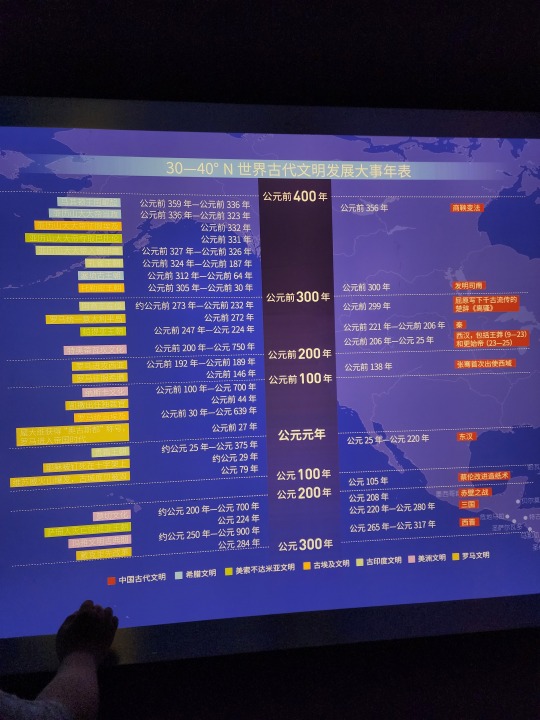
A diagram of the Three Lords and Nine Ministers system (三公九卿制) that was used as the central political structure of ancient China during Qin and Han dynasties, which was replaced by the Three Departments and Six Ministries system (三省六部制) in Sui dynasty (581 - 618 AD). There are many translations for the same positions, here I used what I think fits best for each position.
The Three Lords/三公 are (left to right on chart) : the Imperial Secretary/御史大夫 (handles the audit system and helps the chancellor), the Chancellor/丞相 (helps emperor handle national political affairs), and the Grand Commandant/太尉 (helps emperor handle military affairs).
The Nine Ministers/九卿 are (left to right): the Minister of Finance/治粟内史 (oversees public finance and tax system), the Minister of the Imperial Clan/宗正 (handles affairs within imperial clan), the Grand Herald/典客 (handles foreign policy), the Minister of the Guards/卫尉 (controls imperial guards), the Minister of Justice/廷尉 (oversees judicial system), the Minister of Attendants/郎中令 (controls palace guards, oversees imperial household, serves as imperial advisor, etc.), the Minister Coachman/太仆 (oversees the care, training, use, and purchase of horses; horses were an important resource in ancient times), the Lesser Treasurer/少府 (oversees the emperor's personal finances and some taxes), and the Minister of Ceremonies/奉常 (handles official ceremonies, worship, and rituals, oversees court astrologers and court scribes/historians).
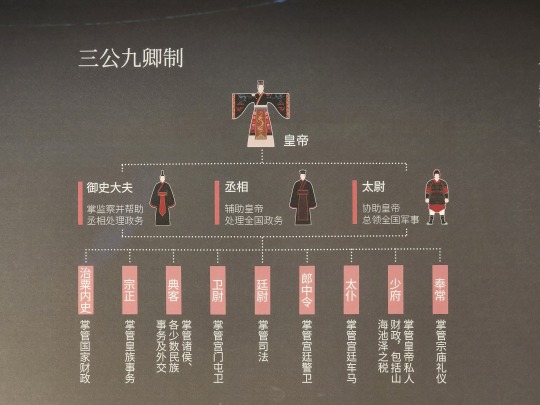
Qin and Han dynasty bureacratic systems. Right is Qin dynasty's system of commanderies/郡, counties/县, townships/乡, and villages/里 (levels of local government from highest to lowest). Left is Han dynasty's central government system, which designated the Three Lords and Nine Ministers system as the Outer Court/外朝 (executes policies), and added a Central Court/中朝 (decides policies).

A list of the 48 commanderies during Qin dynasty and their locations today, grouped by where they were located before Qin dynasty (for example 7 of these groups were states during the Warring States period). A few of the names of these commanderies continue to be place names today, and some others often make appearances in modern novels.
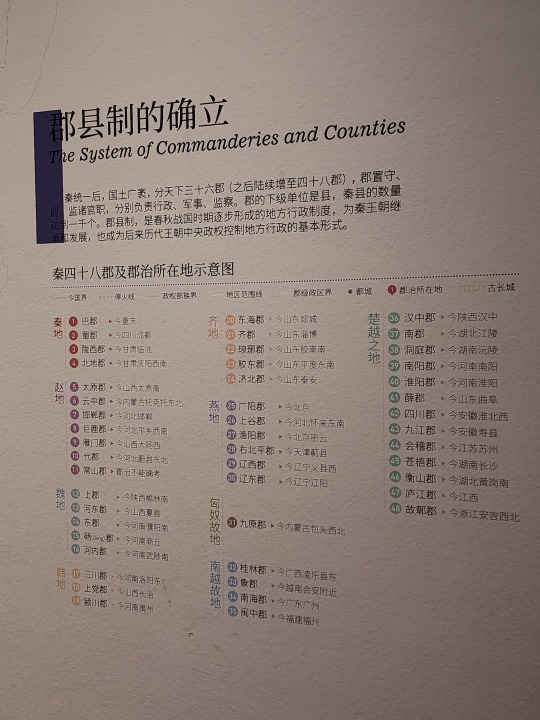
The Recommendatory System/察举制 of Han dynasty, which was how officials were selected. Basically this process consists of a few steps: first the emperor would set what categories of talents are needed, then local government would recommend people to the central government accordingly. The emperor would ask the recommendees how they would deal with current issues, and then gave them positions based on how good their policy ideas were. Ideally the local officials would be impartial with recommendations, but in reality the local officials often belonged to powerful local clans, so these recommendations gradually became a way for the powerful clans to stay in power. This system was replaced by the Imperial Examination System/科举制 in later dynasties, which put more emphasis on exams as a way to select talents.

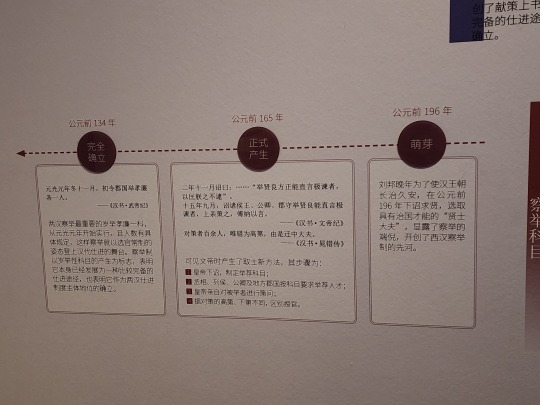
The locations of Qin and Han dynasty national temples, sacred mountains, and sacred bodies of water on a modern map. Of these, the temples marked in yellow were the temples dedicated to eight deities worshipped by the state of Qi, so they are collectively called the Eight Deities of Qi/齐地八神. Although the state of Qin eventually defeated the state of Qi, worship of these deities continued through Qin dynasty into Han dynasty. The temples marked in red were dedicated to deities worshipped by the state of Qin. The temples marked in purple were temples built in Han dynasty. The sacred waters are marked with wavy lines. The sacred mountains are marked in light blue-gray (a few are outside of this picture). MDZS fans may recognize Qishan/岐山 on this map, and Three Kingdoms enthusiasts may recognize jieshishan/碣石山 as the place Cao Cao visited when he wrote the line "东临碣石,以观沧海" in his famous poem.

Replicas of a small part of the Qin-era bamboo texts found in a tomb of a Qin dynasty official at Shuihudi (睡虎地秦简). The originals are at Hubei Provincial Museum/湖北省博物馆. Many of these texts concern laws and decrees of Qin dynasty, and in another tomb in the same area there were also the oldest letters ever found in China (link goes to the full digitized text). These bamboo slips are meant to read from top to bottom, right to left, and the construction of bamboo scrolls are actually the very reason why Chinese texts read this way traditionally even on printed texts during later dynasties.
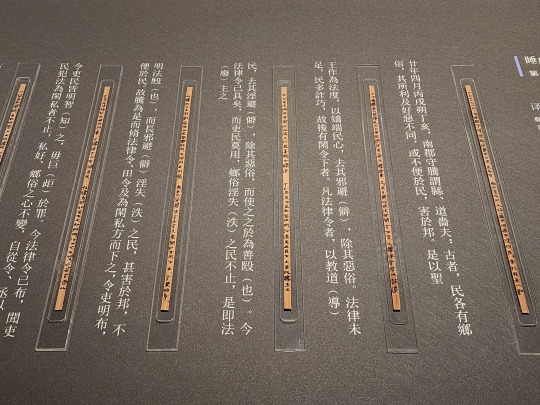
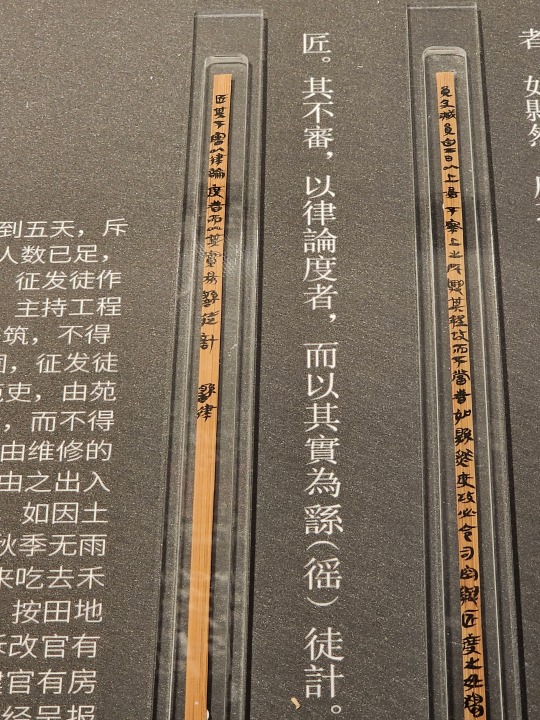
This was something I'd written about in the MDZS posts a few years ago, and now I've finally seen the real thing with my own eyes: the Tiger Tally/虎符 (I translated it as "Tiger Amulet" in that post but in fact "Tally" is the correct translation). Tiger tallys have two halves, each with gilded gold text upon them. This particular artifact is the left half of a tiger tally from late Warring States period (state of Qin), and reads:
"This is a tally of the armed forces, right half goes to the ruler of Qin, left half goes to (the official of) Du county. When the need to dispatch armored troops of over 50 soldiers arises, this half must find the other half held by the ruler in order to authorize this military activity. In case of emergency, there is no need to wait for this authorization." (“兵甲之符,右才君,左才杜。凡兴士披甲用兵五十人以上,必会君符,乃敢行之。燔燧之事,虽毋会符,行殹。”)


The different currencies (coins) of the states of Warring States period:

The different coins and coin molds during Qin and Han dynasties:

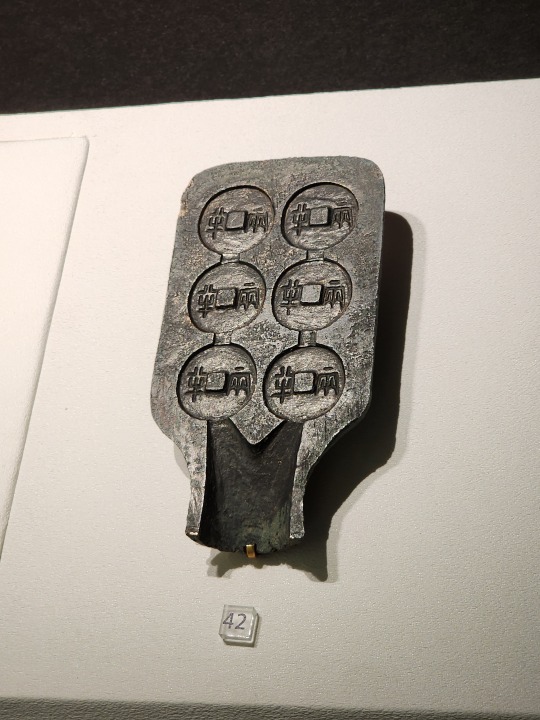


Left: Han dynasty disk-shaped gold ingots; these were rare currencies at the time and were mainly exchanged between the imperial family and nobility as gifts. Right: a standard weight from Qin dynasty that reads "weighs 30 jin/斤". Since Qin dynasty unified systems of measurements, and this weight is known to weigh 7.5 kg, we can easily convert the Qin-era jin to the modern kg (1 Qin-era jin = 0.25 kg).


Terra cotta soldier and horse from Qin Shihuang's mausoleum. As some people have pointed out, these terra cotta soldiers were fully painted and colorful when they were first excavated, but when exposed to air, the paint quickly peeled and the colors faded, leaving the sculptures in their familiar clay-color. Few of these sculptures still have their original colors intact, thanks to preservation efforts. The immense difficulty of preservation is also a reason why modern Chinese archaeology has that rule of "don't excavate unless absolutely necessary".


A Qin-era bronze jian/剑 (double-edged straight sword) from Qin Shihuang's mausoleum:
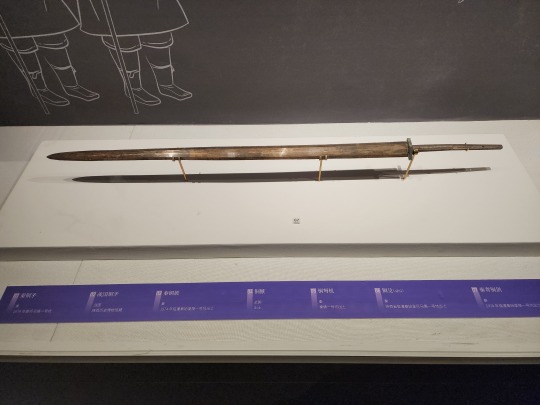
Left: Qin-era bronze spear heads and a pi/铍 head (on the right; pi is a type of ancient Chinese polearm). Right: Han-era ring-pommel dao/环首刀 (dao is a single-edged sword that can be straight or curved; interestingly, many ring-pommel dao artifacts exhibit a forward curve). Ring-pommel dao continued to be used in the military after Han dynasty.
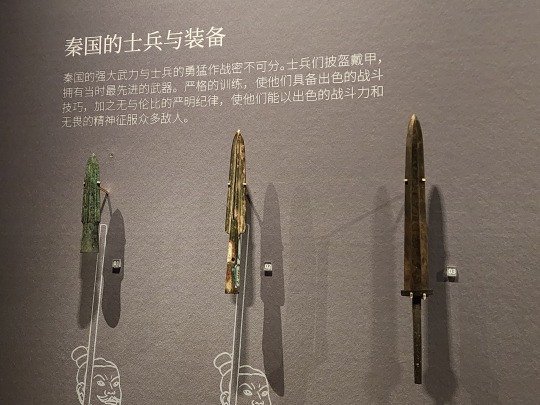

A suit of armor made out of stone from Qin Shihuang's mausoleum. These armor sets weigh about 18 kg or 39.7 lbs each, which is........actually not too bad. There are specialized armor sets in later dynasties that can weigh 30 kg or 66 lbs.
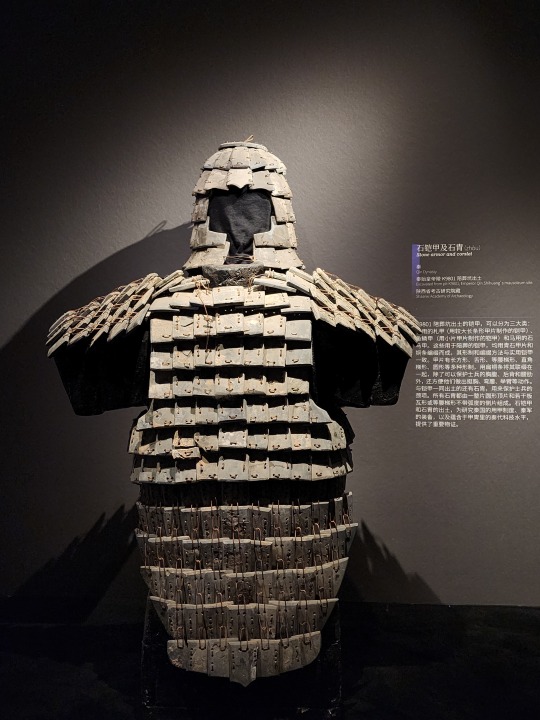
#2024 china#xi'an#china#shaanxi history museum qin and han dynasties branch#chinese history#qin dynasty#han dynasty#warring states period#three kingdoms#history#archaeology#mdzs
81 notes
·
View notes
Text
MULA NAKSHATRA SAGGITARUS MALE OBSERVATION -
Firstly, this is my personal observation pov. It is not meant to hurt anyone. Saggitarus is said to be the funniest zodiac sign in western but in Vedic Astrology, I observed around 5 folks with sagg placement. These are my observations -
- Have a mature mind with a maniac personality. I said what I said.
- Ditched by ex, get into self destructive mode and lose all hope in love. I saw that it was their first love, they got ditched by the women and these folks can't move on with their tragic past.
- Absolutely Bullying and Rude behaviour when it comes to conversation. I didn't enjoy how hyper and bully aura they get.
- They're not interested in History, Astrology, literature research or anything where knowledge is power. They choose their comfort zone and limited resources. I have a hard time talking to them.
- Not a good singer But can play an instrument.
- They have a lot of mental health issues like overthinking, anxiety, depression, alcoholic problems, drugs, etc.
- They're not religious ( weird, but yes once their faith is gone in love. They are not as religious!)
- Humour is dank, lust is there and can be really dom in love.
- They're good in mathematics, Account, tech, stats and numerical analysis
- My crush was a saggitarus moon, I hate to say he was boring af. He has got no talent other than average writing skills.
- Also I observed that they have fixed opinions, they are well versed in the English language and quite comfortable but I felt their Hindi language comes off very arrogant.
- Very Stubborn and reserved nature.
- Not a spiritual person!
#saggitarius#writers on tumblr#astrology#vedic astro observations#vedic astrology#astro community#vedic astro notes#vedic chart#astro observations#astro notes#vedicwisdom#jyotish#birth chart#nakshatra#mula nakshatra
47 notes
·
View notes
Photo

Ancient Christianities: The First Five Hundred Years
Paula Fredriksen is an eminent figure in the field of early Christianity and ancient Judaism, and her knowledge of the historical and religious circumstances surrounding these faiths is well-established. Her writings are essential reading for those curious about how religion, history, and culture interacted in the ancient Mediterranean.
Ancient Christianities: The First Five Hundred Years by Paula Fredriksen conveys precisely written ideas from the result of meticulously analyzing a great deal of historical data. Different branches of Christianity emerged simultaneously in reaction to a flourishing Judaism and an established religion that was not dead but was instead referred to as "paganism" by Christians. By delving into the subject of ancient "Christianities," new light is shown on the religious practices of the ancient cultures of the Mediterranean and the Middle East during the latter 200 years of the 1st century CE. Christian, Pagan, and Jewish faiths are discussed. The book itself contributes significantly to the history of Christianity and explores aspects of other religions.
Paula Fredriksen is a historian of early Christianity and William Goodwin Aurelio Professor of Scripture at Boston University. Early in her career, Fredriksen published writing on topics such as Christian antisemitism, Judaism, and Christianity. Now, in Ancient Christianities, Fredriksen traces the history of Christianity in the ancient Mediterranean from its nativity up to the 5th century. Throughout history, many people believed in the figure of Jesus transforming countries into monotheistic societies, and Fredriksen provides incalculable depth and insight into this process.
From its beginnings as a messianic sect within Second Temple Judaism to its ultimate inclusion into the late Roman imperial government and rise to prominence in the Western world following Roman rule, Fredriksen emphasizes the whole historical trajectory of Christianity from the 1st through 7th centuries. She ties together the intricate network of interactions among supernatural beings, the celestial bodies, spirits, and prophetic forces existing in the ancient "flat-disced" Earth and geocentric universe as well as the many ways in which the Pagan, Jewish, and Christian occupants of the Mediterranean interacted with these beings.
Fredriksen imparts her profound understanding of the history of Christianity and how the doctrines of the Abrahamic faiths have evolved through the ages in clear and understandable writing. In her view, the history of ancient “Christianities” is more deep and nuanced than previously thought, and she intends to "introduce the reader to the complexities and ambiguities, the ironies and surprises and the twists and turns" to reveal this. If you ask Fredriksen, the Christian faith does not have its roots just in Jesus, there is more to the origin story. Through her writing, she hopes to convey the idea that a "large cast of characters" is responsible for shaping modern religion.
According to her, the narrative and development of "Christianities" encompasses a wide range of characters, including aristocratic patrons, eccentric ascetics, gods, devils, angels, magicians, astrologers, and regular folks. The author examines the gradual conversion of numerous non-monotheistic faiths to monotheism over several centuries, drawing parallels and differences across various ethnic and theological traditions.
Theology, Israel, the impact of social factors including diversity, the necessity for governmental control, and persecutions on the development of Christianity are all covered in depth in the chapters that follow. Further discussions touch on the various regions impacted by the Second Temple Matrix, the connections between Jews and pagans, and the incorporation of Jewish people and culture into Greco-Roman civilization.
Historians, theologians, and anyone interested in the origins of one of the world's largest religious groups would benefit from reading this book, which focuses on the transition of Israel and the Jewish message of the end of time to the emergence of different gentile Christianities. With her unconventional viewpoint and extensive knowledge of the subject, Fredriksen offers readers an opportunity to learn something new. Fredriksen has been an excellent resource for scholars of global religions for decades, and her work is truly unique and rich in history; as a result, this is a recommended book. For further reading materials, readers would find Bart D. Ehrman's The Triumph of Christianity: How a Forbidden Religion Swept the World (2018) and Diarmaid MacCulloch's Christianity: The First Three Thousand Years (2009) to be suitable companion reads.
Continue reading...
56 notes
·
View notes
Text
MYSTICAL HISTORY OF ASTROLOGY – HISTORICAL ORIGINS OF ASTROLOGY

The Sumerians in Mesopotamia—a ancient place of Western Asia—had been the primary to begin noting the actions of the planets and stars. In round 3000 BCE, they recorded and diagnosed the distinguished constellations and patterns. Within Mesopotamia, the Babylonians (additionally referred to as the Chaldeans) have become the primary wonderful astronomers. Continuing on from the Sumerians’ research, the Babylonians created the primary zodiac wheel.
At across the quit of the fifth century BCE, Babylonian astronomers divided the ecliptic into 12 equal “symptoms and symptoms,” that correspond to the three hundred and sixty five days of the yr at 30 days every. Each signal contained 30° of celestial longitude, developing the primary recognized celestial coordinate machine. Each phase turned into frequently diagnosed through the call of an animal. The Greeks later furnished the time period for the zodiac once they defined it because the zodiakos kyklos, aka “animal circle.”
Source Link
#astrology#history of astrology#astrology history#history of astrology signs#history#history of astrology timeline#history of astrology documentary#history of astrology in hindi#history of astrology in india#truth and history of astrology#history of yijing astrology#hellenistic astrology#history of western astrology#history of chinese astrology#history of horoscopic astrology#history of astrology and zodiac signs#what is astrology#is astrology real
1 note
·
View note
Text
Explain the basic: What is a Grimoire/book of shadows?
Desclaimer: Everything I will talk about is information that I got from books and sites online and even videos on YouTube. In my years of practice, I learned as much as I could out of curiosity and what works best for me. I suggest you do the same by learning as much as you can on your own (I will be here making posts teaching this kind of stuff) from multiple sources.
A Grimoire and a Book of Shadows are both types of books associated with magical practices, but they serve slightly different purposes and have distinct origins and uses.

Grimoire:
Definition: A grimoire is a textbook of magic, typically including instructions on how to create magical objects like talismans and amulets, how to perform spells, summon spirits, and other magical practices. Historical Context: Grimoires have a long history, with some dating back to the medieval period or earlier. They are often associated with Western esotericism, including traditions such as Hermeticism, alchemy, and ceremonial magic. Contents: A typical grimoire may contain astrological charts, instructions for casting spells, recipes for concoctions, and the proper methods for summoning and controlling spirits or deities. Examples include "The Key of Solomon" and "The Book of Abramelin."
Book of Shadows:
Definition: A Book of Shadows is a personal journal or notebook used by practitioners of Wicca and other forms of modern witchcraft. It serves as a record of magical work, rituals, spells, and personal reflections. Modern Context: The concept of the Book of Shadows was popularized by Gerald Gardner, one of the founders of modern Wicca, in the mid-20th century. It has since become a common practice in many Wiccan and neo-pagan traditions. Contents: A Book of Shadows may include ritual instructions, spell recipes, herb lore, personal reflections, dreams, and experiences with the divine or spiritual realm. It is often highly personalized and may be kept secret or shared with a coven.

Key Differences:
Purpose: Grimoires are typically more formal and instructional, often intended to be comprehensive manuals of magical theory and practice. Books of Shadows are more personal, serving as a magical diary or workbook.
Historical vs. Modern: Grimoires have ancient roots and are part of a historical tradition of magical literature. Books of Shadows are a modern development within contemporary witchcraft and Wicca.
Contents: While there can be overlap, grimoires often focus on detailed magical systems and the mechanics of magic, whereas Books of Shadows emphasize personal experience, practice, and reflections.
Both types of books are integral to their respective magical traditions and are used by practitioners to document and guide their magical work.
#manifestation#manifesting#shifting methods#loa methods#manifestation method#manifesation#spiritual development#journal#explain the method#explained#witchcraft community#witchcraft#witchblr#witch blog#magick#witch#wicca#witchcraft 101#witches#witch community#witchcraft books#grimoire#candle magic#baby witch#book of shadows#green witch#beginner witch
82 notes
·
View notes
Text
Me getting political
🇬🇪🇪🇺
So, I know I mostly only really talk about vedic astrology here, but I'd like to speak to the very same audience who found and followed me because of that about what's going on in my country. So, followers, dear mutuals, those couple of ppl I know irl who are on here, or someone who randomly found this_please, read and interact. (!!!please)
For context, the vast majority Georgia, mainly gen z, has been protesting a "foreign agents law", which is almost identical to the law that russia passed in 2012 and that has resulted in significant restriction of the freedom of its citizens. So, eurovision, met gala, whatever.... this is the reality my country lives in.
I had no idea so many people from other countries were this misinformed about georgia(in general)? People thinking photos from our massive protests were not from here because we have "police" written in english and not "policija"(which is not a fcking georgian word??????)?
People thinking america funded, I repeat, MASSIVE protests that have been going on for a month(and have also taken place in the march of last year for the same reason), just because some of the protestors wrote signs in english? Like, the sheer idea of that is honestly infuriating.
I don't think anyone who has not lived in Georgia will understand the situation clearly. The government is ordering to beat up peaceful protestors, is using pepper spray on them.... and most of the protestors are teens and young adults, trying to make a better future for themselves and for generations to come, tired of fighting the same fight that their parents and grandparents have fought.
When you are born georgian, patriotism is instilled in you like vow. I was born in 2002, a decade after my country exited the soviet union, fresh out of the notoriously hard and dark 90s(full of poverty and crime), six years before I started school and russia invaded the city of Gori. We learned all the poems and novels of our great writers, learned the stories of them fighting for freedom of speech, for the freedom of our country, our teachers would explain every detail of their astristry and their importance. At some point I think we all got tired of it, no matter how loving and full of care they were, but then I remember the presentation my class did in sixth grade about february of 1921, how Georgia exited the russian empire in 1918 and how the brand new(at the time) constitution was implemented just a few days before the red army came in 1921... MY PARENTS were born when Georgia was in ussr, my mother had to spend her years as a young student in the 90s in constant fear of danger on the streets, our parents saw the worst of it and did everything in their power for us to live in a better environment. But we're first generation in georgia who grew up with internet, who is fluent in internet slang and is way more informed, with a completely different mentality, for whom the decades of oppression is more distant. We know russia is an enemy, we know what our country has gone through, but we are the first gen with the freedom to speak up when yet another attemp to control is made.
We have a very long and rich history and one thing that is clear from it is that we are supernaturally resilient, and our refusal to be subdued has protected not only ourselves, but countries that lie west from us, the countries that make Europe, that we consider ourselves a part of.
My friends know I'm the quickest to say that I feel like I don't belong here(georgia), that I never really connected to what I saw, generally, in my country, but maybe there are thousands like me here. Maybe(100%) the men in power haven't been paying their due respect to my generation and how persistent we have been in our actions and convictions. And maybe, the rest of the world(western countries) have significantly undervalued our importance. We deserve our due, and to me, the least that others can do, is to educate themselves before typing or speaking about us.
We are not a "former soviet country", we are an ancient civilization with an extremely unique culture that has survived to this day, that has protected its customs, identity and the right for freedom, and has been under almost constant threat for losing them. And, once again, if there was any doubt, we are not our government.
I sincerely hope for this to get as many notes or possible, or at least, to reach the right people.
#vedic astrology#eurovision#astrology#nakshatras#astrology observations#sidereal astrology#astro notes#astrology tumblr#aesthetic#esc#switzerland#finland#tbilisi#georgia#sakarvelo#saqartvelo#russian law#foreign agents law#georgia is europe#photography#doctor who#northern lights#aurora borealis
149 notes
·
View notes
Text
Where It All Began: The Ancient Roots of Witchcraft

Witchcraft didn’t appear out of nowhere like a mysterious cloaked figure under a full moon. Its roots stretch deep into the soil of human history, sprouting from the primal desire to understand, interact with, and occasionally charm the forces of the natural world. In essence, witchcraft was humanity's first attempt to make sense of life’s mysteries—birth, death, illness, and those pesky harvests that sometimes failed to cooperate.
Mesopotamia: Magic at the Dawn of Civilization
In the ancient lands of Mesopotamia, magic was woven into everyday life like the intricate patterns of a Sumerian tapestry. Priests and priestesses doubled as magicians, using rituals to appease gods or ward off mischief-making demons. The Assyrians and Babylonians developed complex systems of divination, like hepatoscopy (reading the entrails of sacrificed animals) and astrology, where the movements of celestial bodies were believed to influence earthly events. Think of these practices as ancient spreadsheets for managing cosmic chaos.
One standout Mesopotamian magical figure was the āšipu, or exorcist. Armed with incantations and symbolic objects, they combatted evil spirits with the confidence of someone holding a holy water squirt gun. Their spells were recorded on clay tablets, many of which have survived, offering us a peek into their magical toolkit.
Ancient Egypt: Spells, Deities, and Afterlife Insurance
Move over Cleopatra—Egyptian magic deserves its own red-carpet moment. For the Egyptians, magic (heka) wasn’t just a tool but a divine force that existed before creation itself. Gods like Thoth and Isis were thought to wield heka with unparalleled mastery, inspiring humans to follow suit.
The Egyptians had spells for almost everything: curing snake bites, securing a prosperous journey in the afterlife, or even ensuring a good hair day (yes, beauty magic existed). Amulets were their magical multitaskers, offering protection, health, and a little pizzazz. The famous Book of the Dead was essentially a magical user manual for navigating the perils of the afterlife. If reincarnation were an obstacle course, the Egyptians were determined to ace it with cheat codes.
Greece and Rome: The Birth of Western Esotericism
The ancient Greeks and Romans didn’t just dabble in magic—they wrote dissertations on it. In Greece, philosophers like Pythagoras and Plato explored metaphysical concepts that later influenced magical thought. Pythagoras, for example, wasn’t just a math guy; he believed numbers had mystical properties. So next time you curse algebra, remember it might have been a magical tool at some point.
The Greeks also gave us some of the earliest grimoires, such as the Greek Magical Papyri. These texts were chock-full of spells, invocations, and recipes for crafting magical potions. They even included tips for summoning deities or spirits, proving that ancient people also loved a good life hack.
Meanwhile, the Romans took a more practical approach to magic, using it for love, revenge, and keeping those pesky neighbors in check. Curse tablets, thin sheets of lead inscribed with hexes, were buried at sacred sites to call upon the gods for justice. It’s basically the ancient equivalent of subtweeting someone, but with higher stakes.
The Far East: Mysticism and Balance
Across the globe, ancient Chinese and Indian traditions were also steeped in magic and mysticism. In China, Taoist practices incorporated rituals, talismans, and alchemical experiments to achieve harmony with the Tao, or the natural order of the universe. The blending of spirituality and practicality was key, with many rituals aimed at promoting health, longevity, and prosperity.
In India, the Vedic texts described rituals and hymns to invoke divine powers. These practices evolved into a blend of spirituality and mysticism that still influences Hinduism and other traditions today. The emphasis on balance and connection to universal energy feels remarkably modern, doesn’t it?
Shamanism: The Universal Foundation of Magic
Before the rise of organized religions, shamanic traditions thrived across cultures from Siberia to South America. Shamans acted as intermediaries between the physical and spiritual realms, often entering trances to seek guidance or heal their communities. Whether they were chanting, drumming, or consuming psychedelic plants, shamans were the original multi-class characters—part healer, part mystic, part community leader.
The tools of their trade—herbs, bones, and natural objects—laid the foundation for many magical traditions that followed. The use of sympathetic magic (the idea that like affects like, such as using a doll to represent a person) can be traced back to these early practices.
Magic Across Africa and the Americas
In Africa, magic and spirituality were deeply intertwined with everyday life. Practices like Ifa divination in Yoruba culture involved intricate systems of symbols and interpretations, revealing paths to healing, growth, and understanding. Meanwhile, in Mesoamerica, civilizations like the Maya and Aztecs used rituals and offerings to communicate with their gods, often centering around natural cycles like the harvest or the movements of the sun and stars.
The connection to nature in these practices wasn’t just poetic—it was practical. By aligning their magic with the rhythms of the earth, ancient people ensured their survival and fostered a sense of harmony with the world around them.
The Bigger Picture
From the rivers of Mesopotamia to the temples of Egypt and beyond, early witchcraft and magical practices were about survival, connection, and understanding the mysteries of existence. These ancient roots remind us that magic isn’t just about casting spells—it’s about fostering relationships with the forces that shape our world, whether they’re gods, spirits, or the natural elements.
Now, when you light a candle, hold a crystal, or write in your journal, remember: you’re participating in a tradition as old as time. How’s that for a little magic in your day?
#witchblr#witches#witchcraft 101#witchcraft blog#witchcraft info#healing energy#witchythings#witchcraft#witch community#learning magick
22 notes
·
View notes
Text

I hate this revival in hindu astrology by white people/westerners. Bec more than half of them do shit like this where they’re like “I believe in it outside of the cultural context”
It still fucking exists in its cultural context though, you can’t just say you believe in hindu astrology without believing in half the shit it promotes.
You’re appropriating it by saying that you’re “reclaiming” hindu astrology by ignoring all the history behind it and “using it properly” when actually you just want to ignore the fact it’s been and is still used to oppress people
36 notes
·
View notes